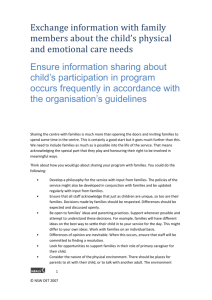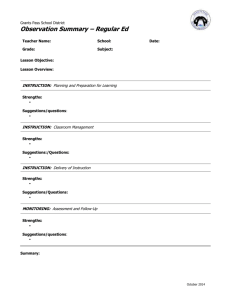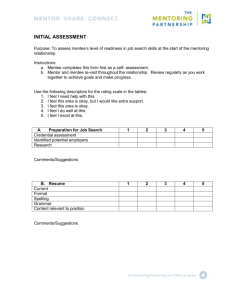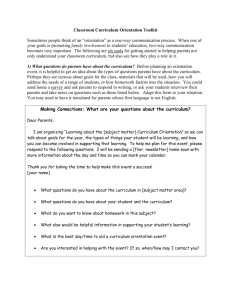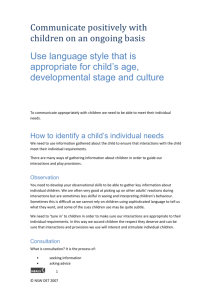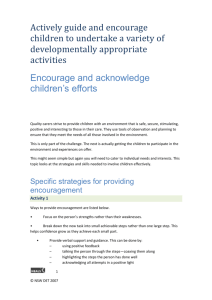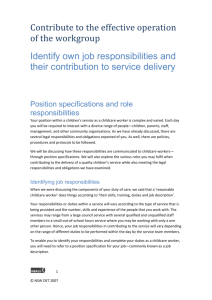Here are the Readings for Support children in learning about the
advertisement
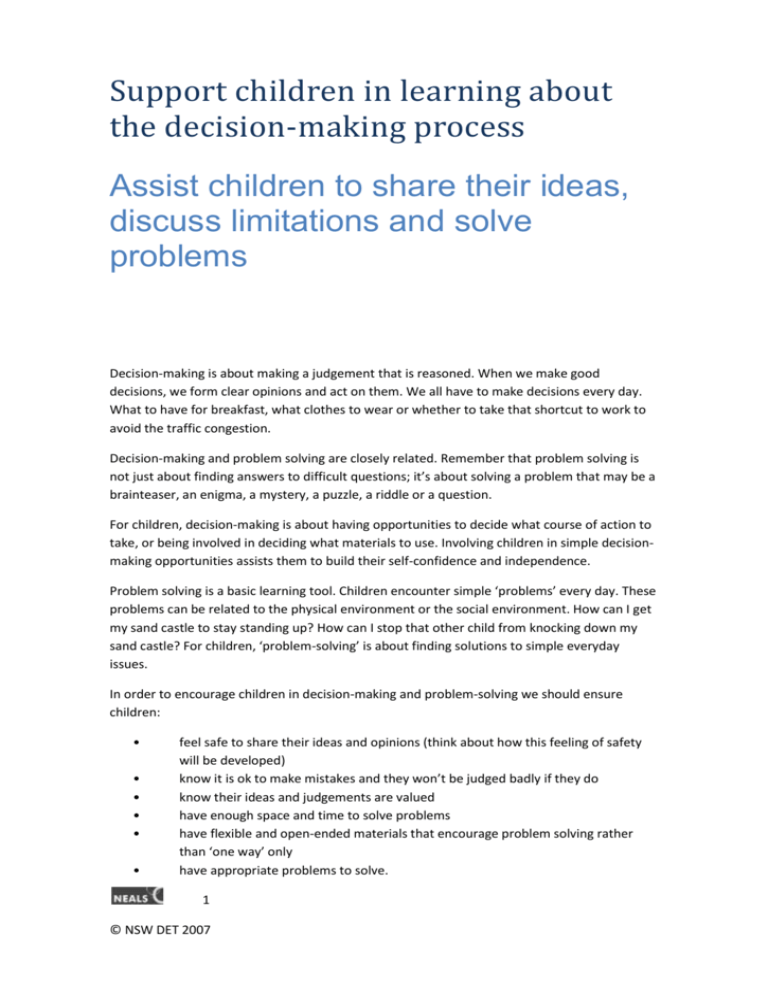
Support children in learning about the decision-making process Assist children to share their ideas, discuss limitations and solve problems Decision-making is about making a judgement that is reasoned. When we make good decisions, we form clear opinions and act on them. We all have to make decisions every day. What to have for breakfast, what clothes to wear or whether to take that shortcut to work to avoid the traffic congestion. Decision-making and problem solving are closely related. Remember that problem solving is not just about finding answers to difficult questions; it’s about solving a problem that may be a brainteaser, an enigma, a mystery, a puzzle, a riddle or a question. For children, decision-making is about having opportunities to decide what course of action to take, or being involved in deciding what materials to use. Involving children in simple decisionmaking opportunities assists them to build their self-confidence and independence. Problem solving is a basic learning tool. Children encounter simple ‘problems’ every day. These problems can be related to the physical environment or the social environment. How can I get my sand castle to stay standing up? How can I stop that other child from knocking down my sand castle? For children, ‘problem-solving’ is about finding solutions to simple everyday issues. In order to encourage children in decision-making and problem-solving we should ensure children: • • • • • • feel safe to share their ideas and opinions (think about how this feeling of safety will be developed) know it is ok to make mistakes and they won’t be judged badly if they do know their ideas and judgements are valued have enough space and time to solve problems have flexible and open-ended materials that encourage problem solving rather than ‘one way’ only have appropriate problems to solve. 1 © NSW DET 2007 When interacting with children we should use strategies and techniques that will help draw out their ideas and thoughts, and support them in solving problems. Here are suggestions: • Questioning. Open-ended questions allow children to explore their ideas. These are questions that begin with ‘why’, ‘how’, ‘what if’ and ‘when’. Brainstorming. It is useful to list all the ideas and then to eliminate the least probable solutions before beginning to carry out the task ie prioritise options—this leads to future understanding of the issues and limitations. Giving choices. This ensures options are explored rather than limiting the children’s creative thinking once they arrive at the first solution – there could be 12 ‘right’ answers. Following through. This is important to show the children that you value the decisions and choices that they make. Considering developmental abilities. Being aware of each child’s developmental level assists the carer in supporting children’s choices and decision making, ie, starting with the simple choices initially then working towards more complex alternatives, as children are able. Developing problem-solving skills. Assisting children to consider a range of possibilities and develop flexible and creative ways of approaching challenges. • • • • • Activity 1 Clearly describe to children limitation of resources In collaborative decision making and allowing children choices there will be many times when our ability to act on children’s decisions and choices is limited by the resources available. The types of limitations we are likely to encounter may be due to: • • • • • • • • costs and budget constraints staff numbers shared nature of resources physical environment available space available equipment time developmental appropriateness. 2 © NSW DET 2007 With appropriate discussion and support, young children can begin to understand that there are limitations that restrict what can be done. However, the developmental abilities of the children need to be taken into account. For example, there is little point in discussing with a two year old the need to take turns and share pieces of scarce equipment. Discuss safety factors and legal requirements that may constrain options There are a number of safety, legal and ethical issues that realistically limit our options of the choices we can offer children, or that limit our ability to follow through with ideas presented by children. Safety and legal requirements that ay constrain options safety regulations (OHS of the service) duty of care state licensing requirements code of ethics UN Rights of the Child health considerations behavioural issues (behaviour guidance policy) sun safe policies weather high risk activities (abseiling) location of activity (near water) consideration of inclusive practices impact upon others group rules that have been developed by the children organisational standards, policies and procedures (staff ratios for excursions). As with resource limitations, the effect of these restraints can be discussed with children depending on their developmental level. Activity 2 3 © NSW DET 2007 Assist children to plan implementation of ideas/ suggestions Activity 3 An important part of problem solving and decision-making is allowing children to try out their ideas in practice. Guidance by supportive carers so that children can implement their ideas and suggestions should begin as soon as possible. Simply responding to a baby’s interest in a particular toy by moving them closer or putting the item with in visual or arm reach is one example. Responding to children’s cues and, later, the use of questioning to give choices during play experiences, mealtimes and routine times can begin at a very early age. Providing appropriate resources that children may request and saying ‘Yes!’ as often as possible encourages children to be confident explorers of their environment. When children’s ideas and suggestions are implemented it gives them a feeling of value and freedom of choice. True collaboration is about focussing on a task or problem and the real giving and taking of ideas for the benefit of the whole group. Initial ideas may seem impossible but we can use brainstorming and mind maps to explore children’s suggestions—and eventually implement them. Brainstorming and mind mapping can be used successfully with children as young as three to follow up interests, draw out ideas for activities and projects and to solve simple every day problems. Mind mapping is a visual record of the ideas and issues presented via brainstorming. The topic is usually written in the middle of the paper or board and children’s responses and ideas are written around the topic, circled and connected to the topic by lines. A mind map is useful as it can be referred back to and added to as ideas develop. In a brainstorming session with young children it is important not to disregard any ideas. Children can be consulted about simple rules like ‘no calling out’ and ‘one person speaks at a time’. 4 © NSW DET 2007 Acknowledge suggestions that cannot be used and explore alternatives with the children It is not always possible or realistic to follow through on children’s ideas and suggestions. This may be due to a number of constraints mentioned earlier or the child’s idea may not be appropriate for a childcare situation. We should always keep an open mind, however, and first ask ourselves ‘Is it possible?’ — just because it hasn’t been done at your centre before, doesn’t mean it can’t be done. Sometimes, though, it is simply not feasible to follow through and in these situations, it is important to acknowledge children’s contributions rather than simply ignore them. It may be that we can discuss the idea further with the child or children to develop an alternative idea or plan that is feasible for the childcare environment. For example, in the scenario above, one of the children suggested that the books be put up higher so the ‘babies won’t get them and tear them’. We need to explain to the children that babies need books too and ask them what types of books could be kept down low and what books could be kept higher. You can guide the discussion so that the children come up with the alternative of placing board books and thicker paged books on the lower shelves so the babies can access them. In all our interactions with children, we should seek to foster their sense of initiative while being mindful of safety and the rights of others. Erik Erikson stressed the importance of children being able to develop a sense of autonomy and initiative in order to avoid a sense of shame and doubt in their own abilities. This builds the foundation for school-aged children to develop a sense of industry, a love of learning and doing, as opposed to a sense of inferiority. 5 © NSW DET 2007
